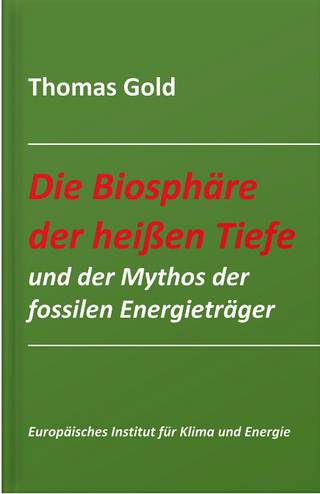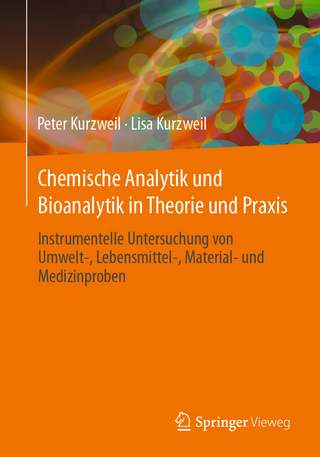
Handbook of Food Science and Technology 3
ISTE Ltd and John Wiley & Sons Inc (Verlag)
978-1-84821-934-2 (ISBN)
Taking into account the fundamental basis and technological specificities of the main food sectors, throughout the three parts of this book, the authors investigate the biological and biochemical conversions and physicochemical treatment of food from animal sources, plant sources and food ingredients.
Romain Jeantet is Deputy Director at the STLO joint research unit INRA-Agrocampus Ouest, as well as Professor at Agrocampus Ouest in Rennes, France. His research focuses on food engineering with a special interest in dairy products. Thomas Croguennec is Professor at Agrocampus Ouest in Rennes, France as well as a Research Scientist at STLO, with research focused on physical chemistry and dairy technology. Pierre Schuck is a research engineer and Partnership Officer at STLO INRA in Rennes, France. He has extensive experience in the dairy industries and his research has largely focused on concentration and drying. Gérard Brulé was Professor Emeritus at Agrocampus Ouest in Rennes, France before he retired in 2010.
Introduction xi
Gérard Brulé
Part 1 Food from Animal Sources 1
Chapter 1 From Milk to Dairy Products 3
Thomas Croguennec, Romain Jeantet and Pierre Schuck
1.1 The biochemistry and physical chemistry of milk 3
1.1.1 Milk fat 4
1.1.2 Carbohydrates 8
1.1.3 Proteins 10
1.1.4 Milk minerals 15
1.2 Biological and physicochemical aspects of milk processing 17
1.2.1 The stability of fat globules 17
1.2.2 Protein stability 19
1.3 Dairy product technology 25
1.3.1 Liquid milk 25
1.3.2 Fermented milk products 29
1.3.3 Milk powder 32
1.3.4 Cheese 39
1.3.5 Cream and butter 58
Chapter 2 From Muscle to Meat and Meat Products 65
Catherine Guérin
2.1 The biochemistry of muscle (land animals and fish) 65
2.1.1 The structure and composition of meat and fish muscle 66
2.1.2 Muscle structure 73
2.1.3 Proteins 78
2.1.4 Carbohydrates 88
2.1.5 Vitamins and minerals 88
2.2 Biological and physicochemical changes in muscle 89
2.2.1 Muscle contraction 89
2.2.2 Changes in muscle after death 91
2.3 Meat and fish processing technology 102
2.3.1 Meat processing technology 102
2.3.2 Fish processing technology 109
Chapter 3 From Eggs to Egg Products 115
Marc Anton, Valérie Lechevalier and Françoise Nau
3.1 Chicken egg – raw material in the egg industry 117
3.1.1 Structure and composition 117
3.1.2 Biochemical and physicochemical properties of the protein and lipid fractions of egg 120
3.2 Physicochemical properties of the different egg fractions 125
3.2.1 Interfacial properties 125
3.2.2 Gelling properties 131
3.3 The egg industry: technology and products 136
3.3.1 Decontamination of shells 138
3.3.2 Breaking and separation of the egg white and yolk 138
3.3.3 Primary processing of egg products – decontamination and stabilization 139
3.3.4 Secondary processing of egg products 142
3.3.5 Egg extracts 143
Part 2 Food from Plant Sources 145
Chapter 4 From Wheat to Bread and Pasta 147
Hubert Chiron and Philippe Roussel
4.1 Biochemistry and physical chemistry of wheat 150
4.1.1 Overall composition 150
4.1.2 Structure and properties of the constituents 154
4.2 Biological and physicochemical factors of wheat processing 163
4.2.1 Development of texture 164
4.2.2 Development of color and flavor 170
4.3 The technology of milling, bread making and pasta making 172
4.3.1 Processing of wheat into flour and semolina 172
4.3.2 Bread making 180
4.3.3 Pasta making 195
Chapter 5 From Barley to Beer 205
Romain Jeantet and Ludivine Perrocheau
5.1 Biochemistry and structure of barley and malt 205
5.1.1 Morphology of barley grain 206
5.1.2 Biochemical composition of barley 207
5.1.3 Composition and structure of starch and protein 208
5.1.4 Effect of malting 209
5.2 Biological and physicochemical factors of processing 213
5.2.1 Enzymatic degradation of starch and protein 214
5.2.2 Fermentability of the wort 220
5.3 Brewing technology 221
5.3.1 Stages of malting 221
5.3.2 Stages of beer production 224
Chapter 6 From Fruit to Fruit Juice and Fermented Products 231
Alain Baron, Mohammad Turk and Jean-Michel Le Quéré
6.1 Fruit development 231
6.1.1 Stages of development 231
6.1.2 Fruit ripening 233
6.2 Biochemistry of fruit juice 237
6.2.1 Pectins 238
6.2.2 Pectinolytic enzymes 241
6.2.3 Bitter and astringent compounds 245
6.3 Fruit juice processing 249
6.3.1 Preparation of fruit 249
6.3.2 Pre-treatment 250
6.3.3 Pressing 250
6.3.4 Treatment of fruit juice 253
6.3.5 Pasteurization, high-pressure treatment, pulsed electric fields and concentration 262
6.4 Cider 264
6.4.1 French cider 264
6.4.2 Fermentation process 265
6.4.3 Action of microorganisms 267
6.4.4 Fermentation and post-fermentation 271
Chapter 7 From Grape to Wine 275
Thomas Croguennec
7.1 Raw materials 276
7.1.1 Grape variety 276
7.1.2 Composition of grapes 276
7.2 Winemaking techniques 280
7.2.1 State of the harvest and adjustments 281
7.2.2 Physicochemical processes involved in winemaking 282
7.2.3 Biological processes involved in winemaking: fermentation 285
7.3 Stabilization and maturation of wine 289
7.3.1 Biological stabilization 289
7.3.2 Physicochemical stabilization 290
7.3.3 Maturation of wine 291
7.4 Specific technology 292
7.4.1 Sparkling wines (traditional method) 292
7.4.2 Sweet wines 293
Chapter 8 From Fruit and Vegetables to Fresh-Cut Products 297
Florence Charles and Patrick Varoquaux
8.1 Respiratory activity of plants 298
8.1.1 Measurement and modeling of respiratory activity 299
8.1.2 Control of respiratory activity 301
8.2 Enzymatic browning 302
8.2.1 Mechanism and evaluation 302
8.2.2 Prevention of enzymatic browning 303
8.3 Unit operations in the production of fresh-cut products: main scientific and technical challenges 304
8.3.1 Raw materials: selection of varieties and cultivation methods 306
8.3.2 Raw material quality control: grading 307
8.3.3 Trimming and mixing 307
8.3.4 Cutting 308
8.3.5 Washing and disinfection 309
8.3.6 Draining and drying 312
8.3.7 Weighing 313
8.3.8 Bagging 313
8.4 Modified atmosphere packaging 314
8.4.1 Diffusion of gases through packaging 315
8.4.2 Change in gas content in modified atmosphere packaging 317
8.5 Conclusion 319
Part 3 Food Ingredients 321
Chapter 9 Functional Properties of Ingredients 323
Gérard Brulé and Thomas Croguennec
9.1 Interactions with water: hydration and thickening properties 324
9.1.1 Types of interaction 324
9.1.2 Influence of hydrophilic components on water availability and mobility 325
9.1.3 Influence of hydration on the solubilization, structure and mobility of compounds 325
9.1.4 Effect of the hydration of components on rheological properties 326
9.2 Intermolecular interactions: texture properties 326
9.2.1 Aggregation/gelation by destabilization of macromolecules or particles 326
9.2.2 Aggregation/gelation by covalent cross-linking 327
9.2.3 Sol–gel transitions 329
9.2.4 Influence of denaturation kinetics and molecular interactions 329
9.3 Interfacial properties: foaming and emulsification 330
9.3.1 Interfacial tension 330
9.3.2 Surfactants 332
9.3.3 Emulsification and foaming 332
Chapter 10 Separation Techniques 335
Thomas Croguennec and Valérie Lechevalier
10.1 Proteins and peptides 335
10.1.1 Milk proteins and peptides 335
10.1.2 Extraction of lysozyme from egg white 346
10.1.3 Extraction of gelatin 348
10.1.4 Plant proteins 349
10.2 Carbohydrates 351
10.2.1 Sucrose 351
10.2.2 Lactose 364
10.2.3 Polysaccharides 369
10.3 Lipids 378
10.3.1 Production of vegetable oils 379
10.3.2 Lipid modification 383
10.4 Pigments and flavorings 391
10.4.1 Types of pigments and flavorings 391
10.4.2 Extraction/concentration of colorings and flavors 397
10.4.3 Formulation 400
Bibliography 403
List of Authors 417
Index 419
| Erscheinungsdatum | 12.06.2016 |
|---|---|
| Verlagsort | London |
| Sprache | englisch |
| Maße | 165 x 241 mm |
| Gewicht | 780 g |
| Themenwelt | Naturwissenschaften ► Biologie ► Biochemie |
| Technik ► Lebensmitteltechnologie | |
| ISBN-10 | 1-84821-934-2 / 1848219342 |
| ISBN-13 | 978-1-84821-934-2 / 9781848219342 |
| Zustand | Neuware |
| Haben Sie eine Frage zum Produkt? |
aus dem Bereich


